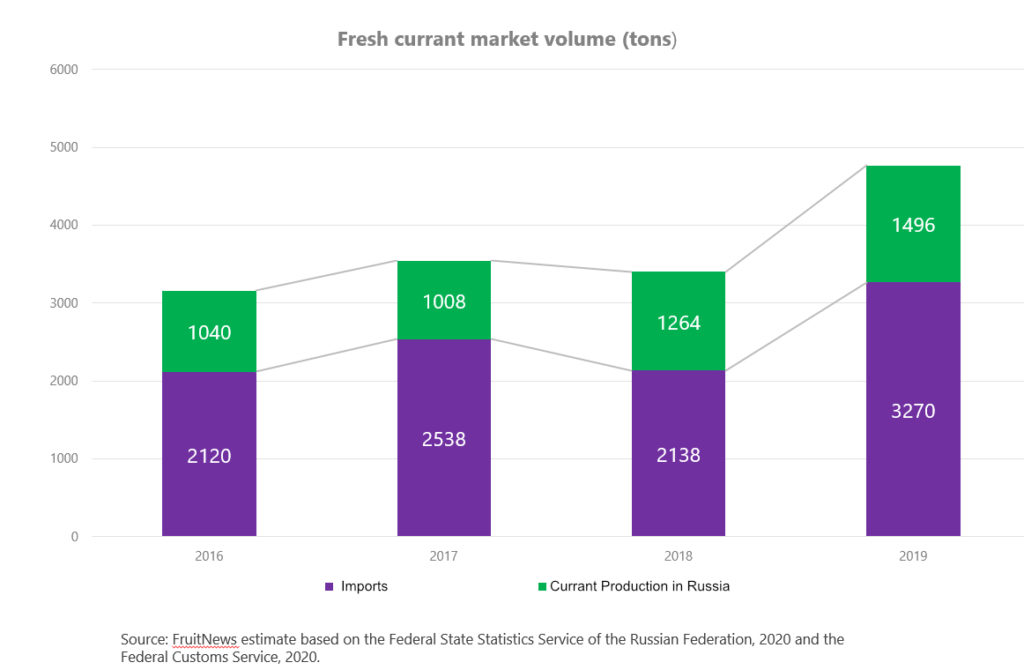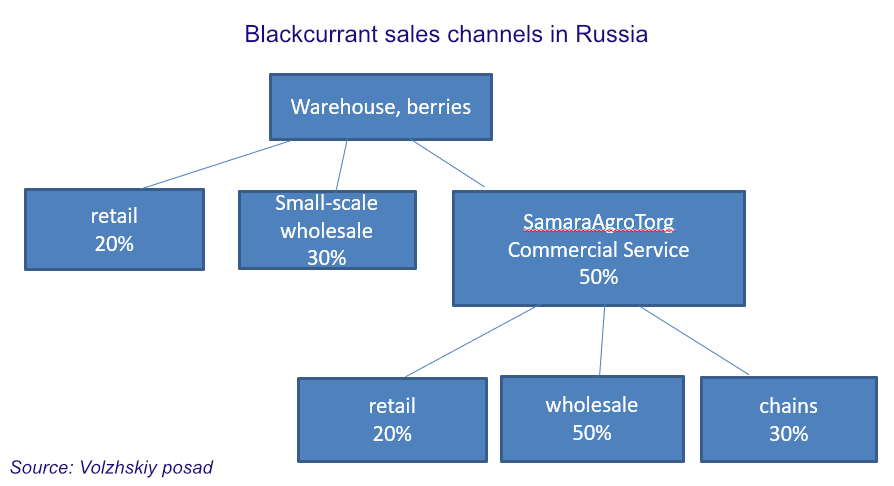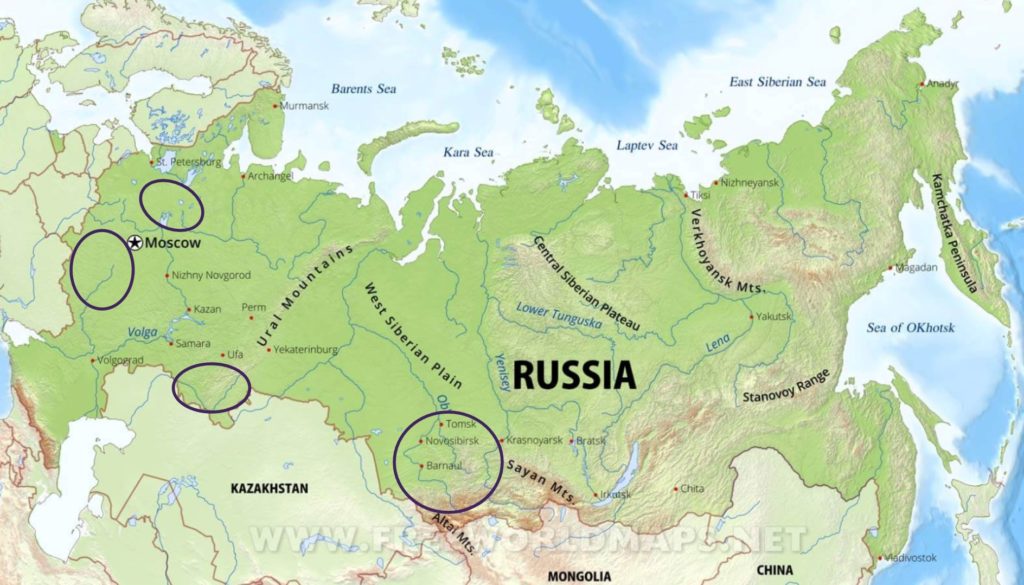Blackcurrant growing in Russia
The efforts of the International Blackcurrant Association to establish contacts with Russia and come to learn more about blackcurrant growing in Russia resulted in a round table of the IBA Executive with the Russian Berry Union, Russian researchers and growers.
We are happy to share what we learned with you in a short version in this post. You may also watch the whole content of the round table on youtube (see at the end of this article), or (for our members) see the presentations in our web library.
When the IBA meets the Russian Berry Union
For many years, the whole blackcurrant family thought that Russia was the country that grows most of the blackcurrants in the world. Although only for a domestic market. The IBA has now managed to get in touch and establish good relationship with the Russian Berry Union. The first round table in February 2021 allowed us to share our experiences. The outcome has been amazing for the IBA: in total, Russia’s growing surface and yield is far below of what we expected – while the market demand is very high.Now, let’s have a closer look into the subject!
1. Industry and market overview
Blackcurrant growing in Russia – an old tradition. But this tradition means mainly that many people grow a few blackcurrant bushes for their own use in their gardens and orchards. Commercial blackcurrant growing is different.
When we look into commercial berry growing in Russia in general, it appears that the berry growing surfaces have largely declined over the past thirty years. From 45.000 hectares in 1990 to 15.000 hectares in 2020. Berry growing in Russia includes mainly strawberries (67%), raspberries and blackberries (14%), currants (8%), gooseberries, rowanberries and buckthorn. Unfortunately, there has been no promotion of internal production of blackcurrants (IQF, fresh or processed). This has led to a decrease of 47% of the growing surface of red and black currants within 10 years from 2006 to 2016.Blackcurrant growing in Russia takes place mainly in Siberia and Ural, but also in the Western parts of Russia, around Moscow.
Market review
The blackcurrant market (whether fresh or processed) has increased by 30% in 2019. 67% are imported blackcurrants (over 3000 tons in 2019), and most of the imports take place in the high season for the fresh market. The blackcurrants come from surrounding countries. Mainly, Belarus supplies Russia with currants, and only a small share comes from Moldavia, Azerbaijan and Serbia.

Russia imports twice as much fresh currants as its own production. The main efforts therefore now go into improving the yields – and thus increase the share of domestic currants in the market.
Difficulties to overcome
But for being successful in increasing the domestic berry production, Russia faces several challenges. The need of efficient and up-to-date plant protection products, authorized in the Russian Federation, is not the only one. It already starts with difficulties in the supply of planting material. As we were told, planting material is mostly self-produced and does not reach the quality standards needed for an efficient production. Furthermore, the lack of knowledge about modern growing technologies, presale preparation and storage of berries increase the difficulties. And finally, when it comes to working in the fields and harvesting, Russia also faces a shortage of skilled staff and seasonal workers.
To sum it up, commercial blackcurrant growing in Russia crucially needs modernization before it can meet the demand of the internal market. Until then, imports will stay a necessity.
2. Key sales channels and quality standards for Russian blackcurrant growers
As we pointed out earlier, reaching the quality standards starts not only with the right land and soil. The Russian blackcurrant growers are missing good planting material and good plant protection products. Many of those used in Europe are not registered in Russia. As a consequence, the yields in Russia are far below the expectations of European growers for their yields. For a Russian blackurrant grower, a good yield for a field with plants of around seven years and with a good irrigation system corresponds to around 2 or 3 tonnes per hectare. This represents only a fourth of a normal harvest in Europe!
Destination and prices
What is totally different in blackcurrant growing in Russia from blackcurrant growing in all other parts of the World is the final destination of the currants. In Russia, 80% of the yield go into the fresh market. This is the reason why harvesting methods are also in the focus of the growers. They now concentrate rather on mechanical harvesting than hand picking – for price reasons. Of course, harvesting with machines costs eight times less than hand picking. The calculation is simple: for a grower, the cost of one kilo of handpicked blackcurrants is 80 Rubels. This corresponds to around 0.90€. For being profitable, he should sell them for 250 Rubels – 2.90€. The average price of blackcurrants in the market is of 80-100 Rubels (around 1€) per kilo, though. And the price goes down as the season advances.
Blackcurrant sales channels in Russia
Furthermore, storing blackcurrants is of big interest to the growers. Blackcurrants can be stored without specific cooling systems at around 8°C for a maximum of 10 days. This is pretty close to the practices in Europe. There is no solution either for storing our little black pearls for the fresh market. Yet, the fresh market in Europe does not count as much as the fresh market in Russia! Finally, blackcurrant growing in Russia struggles with the same challenges than in Europe. Above all others is weeding. Drought and other bad weather conditions have also come into the center of attention lately.
Finally, blackcurrant growing in Russia struggles with the same challenges than in Europe. Above all others is weeding. Drought and other bad weather conditions have also come into the center of attention lately.
As a conclusion to ever-lasting interrogations, we can see that the situation for blackcurrant growing in Russia is more difficult than in Europe. This is due to the final use of the fruit (fresh market!) and the same climatic and agronomic challenges than anywhere else. Yet, at the starting point with planting material, fertilizers and plant protection products, the Russian growers don’t benefit from the same “comfort” than growers in Europe.
3. Most popular varieties for blackcurrant growing in Russia
In its varietal research, Russia concentrates on yield, fruit size and compatibility with mechanical harvest, which is the future for blackcurrant growing in Russia.
Just like in most other countries of the World, people in Russia tend to move towards a healthier lifestyle. They focus on organic and healthy food – instead of fast food. Not surprisingly, berries have a high potential in this market.The average fruit consumption in Russia is of 100 kg per year and per capita. Berries represent 7 kg. We mentioned that Russia imports the biggest share of the berries. In general, imports represented approximately 50 000 tonnes per year! The growing surfaces have again decreased in 2019, though, and the trend goes on.
Criteria for varietal selection
All recent varieties developed by the Russian Research Institute are suitable for mechanical harvesting methods.Blackcurrants have the advantage of containing many nutrients, and moreover giving a high yield. Mecanisation is possible in almost every stage of the process. This is why they are one of the leading cultures in Russia.
One new variety every year
In the last 20 years, more than 20 varieties have been brought into the market. 11 of them are resistent to mildew, some to gall mite and some to rust. Varieties like Arabka, Chrivanya, Chernavka and Niura have high potential for the growers. The Institute, alongside the development of new varieties, also provides consultancy to the growers.
4. Blackcurrant growing technologies
Globally, the difficulties to overcome are similar to the ones in Europe. Nevertheless, the climatic conditions in Russia are not the same.
It is in fact important to provide the market with the appropriate varieties of blackcurrants. The goal for the breeders is to adjust to the climate change – and already, several varieties are available. Another solution would be to find new places for blackcurrant growing in Russia.
Climatic challenges throughout the year
Of course, the varieties should be resistent to certain pests and diseases – which is true for any variety in any part of the World. Stress factors in Russia are:
– frost periods in winter (with temperatures that should not go below -5° for too long).
– in spring: frost, moisture in the soil, and big differences in temperatures between day and night.
– heat threatens the quality and quantity of the yield in summer.
– in autumn: periods of cold without snow.
For cost-effectiveness, aim at 7-9 tonnes / hectare
In terms of cultivation, Russian agronomists recommend to select the varieties according to their production potential. A grower should plant up to 5.700 plants per hectare. A field is cost effective only with a yield of 6-8 tonnes / hectare. In total, 30-50 hectares land are necessary for a culture to be profitable in Russia. To achieve profitability, it is recommended to follow the advice of specialists. The space between shrubs, between the lines, pruning and shaping the shrubs to allow mecanical harvest are essential for success.
A successful meeting
The experience of sharing our knowledge and learn from each other was especially positive during the round table. Almost 5 hours of videoconferencing with simultaneous translation made it possible for everyone to get an insight into each others markets and growing technologies. It opened our eyes and minds, and we will certainly all take profit from this experience in the long term.
As we could see, the criteria for variety selection, growing methods and harvesting (including machines) are very different in Russia. Climate plays a major role for the growers. The requirements for blackcurrant growing in Russia are different from other countries.
On the other hand, the popularity of the fruit itself is totally different. Blackcurrant is a major fruit for Russians, especially as fresh, raw fruit.
Our thanks for a deep insight into blackcurrant growing in Russia go to Irina Koziy – General Director of the Russian Berry Union and Fruit News Information Agency, Irina Kozlova – Leading Researcher of the Federal Scientific Center Michuring, Wladislaw Khanov – Chief Agronomist for horticulture of Sady Privolzhiya of Volzhskiy Posad Group and fruit and berry grower of 1000 ha, including about 80 ha of blackcurrants, Elena Kardapolova – Executive Director of Surgutskoe Co, fruit and berry grower on 2000 ha, including 36 ha of blackcurrants and planting material supplier, Anastasia Bakhotskaya – Researcher of the All-Russia Research Institute of Orchard Cultures Breeding and Tatiana Zhidekhina – Deputy Director of the Federal Scientific Center Michuring.
View the full video of the round table
